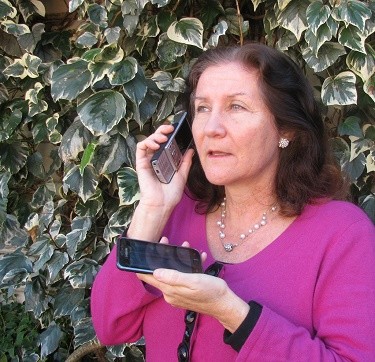The Mobile Revolution for people who are blind or have low vision

If you’ve ever watched an episode of Star Trek, you will doubtless recall how the crew of the Starship Enterprise was able to keep in touch with each other by means of a small device, called a communicator, attached to their uniforms, and to access data and a galaxy of other information via hand-held tricorders. In the 60s, 70s, and 80s, this was far-in-the-future, pipedream, science-fiction stuff. But in the early 90s, science fiction started becoming reality with the introduction of mobile phones. By the early 2000s, we regularly communicated on the go using Short Message Service (SMS) text messages, and soon e-mail and Web browsing capabilities were added to our cell phones, which we dubbed “smartphones.”
Over the past several years the number of smartphone users has exploded. The capabilities of these devices have doubled and redoubled so that today we can carry a device in our pocket that has more processing power and memory storage than that possessed by the world’s fastest supercomputers of just a few decades ago. Today you can check your e-mail, the weather forecast, or a stock quote on your mobile device. Want to know which movie won the Oscar for Best Picture in 1973? Speak to your smartphone and ask the question, from anywhere, and in a second or so you’ll have the answer: The Sting, starring Paul Newman and Robert Redford. Want to watch it? Use your smartphone to log onto Netflix, Amazon Instant Video, or another online video streaming service and you can watch it right on your phone. You could also choose to view The Sting on a touch tablet like the iPad, which includes most of the capabilities and features of a smartphone with a larger display.
If you’ve used a smartphone these past several years, you already know that a great deal of voice command capabilities come built into most current models, so you can verbally instruct your smartphone to “Call my wife,” or “Read my last text message.” In addition, the three major smartphone platforms—Apple iOS, Google Android, and Microsoft Windows Phone—all include built-in screen readers similar to those that allow you to use your PC or Mac computer with little or even no vision. So, now you can read a webpage, compose an e-mail, or use your phone’s GPS function to help you find the nearest coffee shop.
Most smartphones have replaced a majority of their physical buttons and other controls with visual icons that appear on a smooth glass touchscreen. You use a finger to select and activate these icons, and to enter phone numbers, messages, and other text via visual representations of keyboards and number pads. At first glance, so to speak, a touchscreen would appear to present insurmountable difficulties for those with visual impairments. You may be saying to yourself, “On my home phone I can still feel my way across, up, and down the keypad to dial a number. How can I find the right number on a flat piece of glass?”
This guide will show you exactly how this is possible. By the time you finish, you will feel empowered to use your smartphone in new ways or to purchase your first smartphone and enjoy a world of data and communications you can carry with you everywhere.
This article was written and published by the American Foundation for the Blind and authored by Bill Holton, AccessWorld Correspondent. To read the article in its entirety, you can visit this link https://www.afb.org/blindness-and-low-vision/using-technology/cell-phones-tablets-mobile
We Are Here To Help
To learn more about our products and services or to schedule a no-obligation demonstration, contact a Technology Specialist at New England Low Vision and Blindness to learn more. You can also call our toll free number 888-211-6933 or email us at info@nelowvision.com.
Our two(2) state-of-the-art technology showrooms are a wonderful resource, showcasing a variety of leading electronic low vision magnifiers and blindness products. You can schedule an appointment with one of our Technology Specialist who can help you find the right technology, training and care solution.
If you cannot come to us, our staff can even drive out and bring our Vision Store to you, for a no-obligation product demonstration. We offer a comprehensive line of products including electronic magnification low vision aids, blindness products, and leading low vision products for people with glaucoma, macular degeneration and other forms of vision loss.



